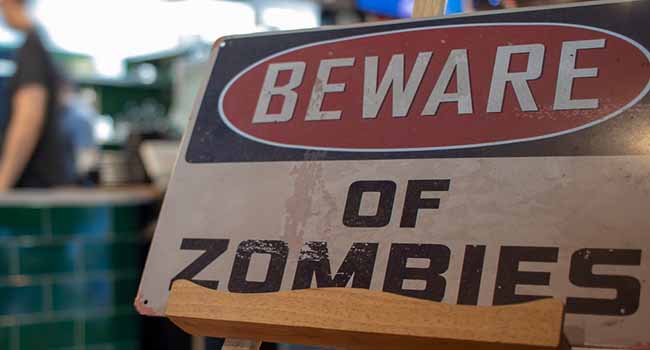 We spend double the amount of time on our streaming platforms compared to last year, close to 45.4 billion minutes on Netflix alone in the first few weeks of March 2020.
We spend double the amount of time on our streaming platforms compared to last year, close to 45.4 billion minutes on Netflix alone in the first few weeks of March 2020.
Movie titles such as 28 Weeks Later, Quarantine, Carriers and I Am Legend have provided an escape from our quarantined hideouts. Unfortunately, such movies about a virus-infected planet and roaming zombies are a bit too real to be pure entertainment.
Rest assured, COVID-19 is not a Hollywood make-believe. It’s a very serious virus working its way around the planet, infecting at least 2.5 million people and resulting in more than 175,000 deaths.
The battle against this virus seems to have leapt off the pages of a Hollywood script into reality, but so too has the battle of the zombies.
These zombies are not the same as the ones found in movies or video games. They were already among us, pre-COVID-19, and have been slowly increasing in number since the 1990s.
Recent measures by the federal government and the Bank of Canada to battle the economic fallout from COVID-19 will lead to a further rise of zombies or, more specifically, an increase in zombie firms.
A zombie firm is any business that, over an extended period, can’t pay its debt-servicing costs from its current profits.
Pre-COVID, the Bank of Canada found zombie firms to have been on the rise in Canada since the 1990s, estimating that 10 to 25 per cent of Canadian companies could be classified as zombies. Furthermore, the bank noted that Canada’s zombie firm infection rate is greater than other countries.
The World Health Organization (WHO) declared COVID-19 a pandemic on March 11, based on the reports that the number of cases of COVID-19 outside China had increased 13-fold and that the number of affected countries had tripled over a two week period (118,000-plus cases in 114 countries and 4,291 deaths). One month later the total number of cases globally had risen 1,340 per cent to more than 1.7 million cases and at least 103,257 deaths (2,306.4 per cent).
In light of such staggering numbers, many countries declared states of emergency and ordered non-essential businesses to close.
In Canada, all provinces declared states of public health emergency by March 26, and ordered the closure of all non-essential businesses by April 1. The provincial orders all indicate such orders will be in place until the COVID-19 threat is deemed over. That leads to billion-plus-dollar questions.
Some health experts estimate that a COVID-19 vaccine could take up to two years to develop. Virologists believe the pandemic will end either when a vaccine is developed or once the population attains herd immunity.
The S&P/TSX Composite Index represents about 70 per cent of the total market capitalization of the Toronto Stock Exchange. The past several weeks have seen a significant drop in the index.
The federal government’s economic response plan, slated to last until June 6, includes wage subsidies of 75 per cent of an employee’s wages for employers of all sizes and across all sectors who have suffered a drop in gross revenues of at least 15 per cent in March, and 30 per cent in April and May.
The Bank of Canada has lowered interest rates, and begun purchasing government of Canada securities and Canada Mortgage Bonds (CMBs), all in an effort to improve market liquidity. Such measures are in line with standard economic thought.
However, such actions reduce financial pressure on firms and create very low interest rate environments. These conditions are perfect for causing a rise in zombie firms.
Studies show significant increases in zombie firms in the wake of financial crises and low interest rate environments that usually follow. With the best projections expecting Canadian companies to lose at least one entire fiscal quarter, and the worst scenario up to an entire fiscal year, we should expect that zombie firm infection rates will dramatically rise.
This not the fiction of an onslaught of zombies in movies or video games. The economic impact zombie firms have on an economy is very real.
Zombie firms have much lower labour and factor productivity, and crowd out potential growth and investment opportunities for productive firms. Not only do zombie firms waste resources, depress product prices, and raise wage and funding costs for productive firms, they distort the debt markets and dilute economic measures meant to provide assistance to the economy.
As the COVID-19 curve flattens and the end of the first wave draws closer, it will be important for governments to focus on the rise of zombie firms to ensure resources don’t go to waste.
Gerard Lucyshyn is the vice-president of research and a senior fellow with the Frontier Centre for Public Policy.
Gerard is a Troy Media Thought Leader. Why aren’t you?
The views, opinions and positions expressed by columnists and contributors are the author’s alone. They do not inherently or expressly reflect the views, opinions and/or positions of our publication.


